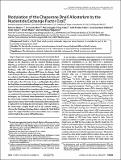Por favor, use este identificador para citar o enlazar a este item:
http://hdl.handle.net/10261/154158COMPARTIR / EXPORTAR:
 SHARE SHARE
 CORE
BASE CORE
BASE
|
|
| Visualizar otros formatos: MARC | Dublin Core | RDF | ORE | MODS | METS | DIDL | DATACITE | |

| Campo DC | Valor | Lengua/Idioma |
|---|---|---|
| dc.contributor.author | Melero, Roberto | es_ES |
| dc.contributor.author | Moro, Fernando | es_ES |
| dc.contributor.author | Pérez-Calvo, María Ángeles | es_ES |
| dc.contributor.author | Perales-Calvo, Judit | es_ES |
| dc.contributor.author | Quintana-Gallardo, Lucía | es_ES |
| dc.contributor.author | Llorca, Óscar | es_ES |
| dc.contributor.author | Muga, Arturo | es_ES |
| dc.contributor.author | Valpuesta, José M. | es_ES |
| dc.date.accessioned | 2017-08-17T10:32:27Z | - |
| dc.date.available | 2017-08-17T10:32:27Z | - |
| dc.date.issued | 2015-03-04 | - |
| dc.identifier.citation | J Biol Chem.290(16):10083-92 (2015) | es_ES |
| dc.identifier.issn | 0021-9258 | - |
| dc.identifier.uri | http://hdl.handle.net/10261/154158 | - |
| dc.description | 10 p.-6 fig. | es_ES |
| dc.description.abstract | Hsp70 chaperones comprise two domains, the nucleotide-binding domain (Hsp70NBD), responsible for structural and functional changes in the chaperone, and the substrate-binding domain (Hsp70SBD), involved in substrate interaction. Substrate binding and release in Hsp70 is controlled by the nucleotide state of DnaKNBD, with ATP inducing the open, substrate-receptive DnaKSBD conformation, whereas ADP forces its closure. DnaK cycles between the two conformations through interaction with two cofactors, the Hsp40 co-chaperones (DnaJ in Escherichia coli) induce the ADP state, and the nucleotide exchange factors (GrpE in E. coli) induce the ATP state. X-ray crystallography showed that the GrpE dimer is a nucleotide exchange factor that works by interaction of one of its monomers with DnaKNBD. DnaKSBD location in this complex is debated; there is evidence that it interacts with the GrpE N-terminal disordered region, far from DnaKNBD. Although we confirmed this interaction using biochemical and biophysical techniques, our EM-based three-dimensional reconstruction of the DnaK-GrpE complex located DnaKSBD near DnaKNBD. This apparent discrepancy between the functional and structural results is explained by our finding that the tail region of the GrpE dimer in the DnaK-GrpE complex bends and its tip contacts DnaKSBD, whereas the DnaKNBD-DnaKSBD linker contacts the GrpE helical region. We suggest that these interactions define a more complex role for GrpE in the control of DnaK function. | es_ES |
| dc.description.sponsorship | This work was supported in part by Spanish Ministry of Economy and Innovation Grants BFU2013-44202 (to J. M. V.), SAF2011-22988 (to O. L.), and BFU2013-47059 (to A. M.), Madrid Regional Government Grants S2013/MIT-2807 (to J. M. V.) and S2010/BMD-2316 (to O. L.), and Basque Government Grant IT709-13 (to A. M.). | es_ES |
| dc.language.iso | eng | es_ES |
| dc.publisher | American Society for Biochemistry and Molecular Biology | es_ES |
| dc.relation | info:eu-repo/grantAgreement/MINECO/Plan Estatal de Investigación Científica y Técnica y de Innovación 2013-2016/BFU2013-44202-P | es_ES |
| dc.relation | info:eu-repo/grantAgreement/MINECO/Plan Estatal de Investigación Científica y Técnica y de Innovación 2013-2016/BFU2013-47059-P | es_ES |
| dc.relation.isversionof | Publisher's version | es_ES |
| dc.rights | openAccess | es_ES |
| dc.subject | 70-Kilodalton heat shock protein (Hsp70) | es_ES |
| dc.subject | Chaperone | es_ES |
| dc.subject | Chaperone DnaK (DnaK) | es_ES |
| dc.subject | Electron microscopy (EM) | es_ES |
| dc.subject | GrpE | es_ES |
| dc.subject | Nucleotide exchange factor | es_ES |
| dc.subject | Protein folding | es_ES |
| dc.title | Modulation of the chaperone DnaK allosterism by the nucleotide exchange factor GrpE | es_ES |
| dc.type | artículo | es_ES |
| dc.identifier.doi | 10.1074/jbc.M114.623371 | - |
| dc.description.peerreviewed | Peer reviewed | es_ES |
| dc.relation.publisherversion | http://dx.doi.org/10.1074/jbc.M114.623371 | es_ES |
| dc.identifier.e-issn | 1083-351X | - |
| dc.contributor.funder | Ministerio de Ciencia e Innovación (España) | es_ES |
| dc.contributor.funder | Comunidad de Madrid | es_ES |
| dc.contributor.funder | Eusko Jaurlaritza | es_ES |
| dc.relation.csic | Sí | es_ES |
| oprm.item.hasRevision | no ko 0 false | * |
| dc.identifier.funder | http://dx.doi.org/10.13039/501100004837 | es_ES |
| dc.identifier.funder | http://dx.doi.org/10.13039/501100003086 | es_ES |
| dc.identifier.funder | http://dx.doi.org/10.13039/100012818 | es_ES |
| dc.identifier.pmid | 25739641 | - |
| dc.type.coar | http://purl.org/coar/resource_type/c_6501 | es_ES |
| item.openairecristype | http://purl.org/coar/resource_type/c_18cf | - |
| item.fulltext | With Fulltext | - |
| item.cerifentitytype | Publications | - |
| item.openairetype | artículo | - |
| item.languageiso639-1 | en | - |
| item.grantfulltext | open | - |
| Aparece en las colecciones: | (CIB) Artículos (IBF) Artículos | |
Ficheros en este ítem:
| Fichero | Descripción | Tamaño | Formato | |
|---|---|---|---|---|
| JBC 2015.pdf | Artículo principal | 1,66 MB | Adobe PDF |  Visualizar/Abrir |
CORE Recommender
PubMed Central
Citations
12
checked on 05-abr-2024
SCOPUSTM
Citations
19
checked on 13-abr-2024
WEB OF SCIENCETM
Citations
18
checked on 29-feb-2024
Page view(s)
296
checked on 18-abr-2024
Download(s)
219
checked on 18-abr-2024
Google ScholarTM
Check
Altmetric
Altmetric
Artículos relacionados:
NOTA: Los ítems de Digital.CSIC están protegidos por copyright, con todos los derechos reservados, a menos que se indique lo contrario.
